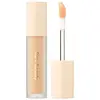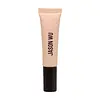What's inside
What's inside
 Key Ingredients
Key Ingredients

 Benefits
Benefits

 Concerns
Concerns

 Ingredients Side-by-side
Ingredients Side-by-side

Water
Skin ConditioningIsododecane
EmollientTalc
AbrasiveDimethicone
EmollientCetyl PEG/PPG-10/1 Dimethicone
EmulsifyingPolysilicone-11
Trimethylsiloxysilicate
EmollientGlycerin
HumectantPhenoxyethanol
PreservativeSodium Chloride
MaskingMagnesium Sulfate
Hydrogen Dimethicone
Sodium Dehydroacetate
PreservativeDisteardimonium Hectorite
StabilisingAluminum Hydroxide
EmollientBenzoic Acid
MaskingDehydroacetic Acid
PreservativeLaureth-12
EmulsifyingPropylene Carbonate
SolventEthylhexylglycerin
Skin ConditioningCI 77891
Cosmetic ColorantIron Oxides
Water, Isododecane, Talc, Dimethicone, Cetyl PEG/PPG-10/1 Dimethicone, Polysilicone-11, Trimethylsiloxysilicate, Glycerin, Phenoxyethanol, Sodium Chloride, Magnesium Sulfate, Hydrogen Dimethicone, Sodium Dehydroacetate, Disteardimonium Hectorite, Aluminum Hydroxide, Benzoic Acid, Dehydroacetic Acid, Laureth-12, Propylene Carbonate, Ethylhexylglycerin, CI 77891, Iron Oxides
Water
Skin ConditioningPhenyl Trimethicone
Skin ConditioningDimethicone
EmollientCyclopentasiloxane
EmollientButylene Glycol
HumectantTrimethylsiloxysilicate
EmollientPEG-10 Dimethicone
Skin ConditioningCetyl PEG/PPG-10/1 Dimethicone
EmulsifyingDimethicone Crosspolymer
Emulsion StabilisingPhenoxyethanol
PreservativeQuaternium-18 Bentonite
Triethoxycaprylylsilane
Silica Dimethyl Silylate
EmollientTrimethoxycaprylylsilane
SmoothingBenzoic Acid
MaskingDisodium EDTA
Panthenol
Skin ConditioningTocopheryl Acetate
AntioxidantDehydroacetic Acid
PreservativePropylene Glycol
HumectantTalc
AbrasiveEthylhexylglycerin
Skin ConditioningCentaurea Cyanus Flower Extract
AstringentIron Oxides
CI 77891
Cosmetic ColorantWater, Phenyl Trimethicone, Dimethicone, Cyclopentasiloxane, Butylene Glycol, Trimethylsiloxysilicate, PEG-10 Dimethicone, Cetyl PEG/PPG-10/1 Dimethicone, Dimethicone Crosspolymer, Phenoxyethanol, Quaternium-18 Bentonite, Triethoxycaprylylsilane, Silica Dimethyl Silylate, Trimethoxycaprylylsilane, Benzoic Acid, Disodium EDTA, Panthenol, Tocopheryl Acetate, Dehydroacetic Acid, Propylene Glycol, Talc, Ethylhexylglycerin, Centaurea Cyanus Flower Extract, Iron Oxides, CI 77891
 Reviews
Reviews

Ingredients Explained
These ingredients are found in both products.
Ingredients higher up in an ingredient list are typically present in a larger amount.
Benzoic Acid is used to preserve and adjust the pH of products.
The antimicrobial property of Benzoic Acid helps elongate a product's shelf life. Its main role is to reduce fungi growth and is not found to be effective at fighting bacteria. Therefore Benzoic Acid is always added along with other preservatives.
In its pure form, Benzoic Acid looks like a white crystalline solid. It has slight solubility in water.
The name of Benzoic Acid comes from gum benzoin, which used to be the sole source of deriving this ingredient. Benzoic Acid is the most simple aromatic carboxylic acid.
Benzoic Acid is naturally occuring in strawberries, mustard, cinnamon, and cloves. It has a slight scent but is not considered to be a fragrance.
Learn more about Benzoic AcidThis ingredient is a high molecular weight silicone. It has emulsifying and skin conditioning properties.
Ci 77891 is a white pigment from Titanium dioxide. It is naturally found in minerals such as rutile and ilmenite.
It's main function is to add a white color to cosmetics. It can also be mixed with other colors to create different shades.
Ci 77891 is commonly found in sunscreens due to its ability to block UV rays.
Learn more about CI 77891Dehydroacetic Acid is fungicide and bactericide. It is used as a preservative in cosmetics. Preservatives help elongate the shelf life of a product.
Dehydroacetic Acid is not soluble in water.
Dimethicone is a type of synthetic silicone created from natural materials such as quartz.
What it does:
Dimethicone comes in different viscosities:
Depending on the viscosity, dimethicone has different properties.
Ingredients lists don't always show which type is used, so we recommend reaching out to the brand if you have questions about the viscosity.
This ingredient is unlikely to cause irritation because it does not get absorbed into skin. However, people with silicone allergies should be careful about using this ingredient.
Note: Dimethicone may contribute to pilling. This is because it is not oil or water soluble, so pilling may occur when layered with products. When mixed with heavy oils in a formula, the outcome is also quite greasy.
Learn more about DimethiconeEthylhexylglycerin (we can't pronounce this either) is commonly used as a preservative and skin softener. It is derived from glyceryl.
You might see Ethylhexylglycerin often paired with other preservatives such as phenoxyethanol. Ethylhexylglycerin has been found to increase the effectiveness of these other preservatives.
Phenoxyethanol is a preservative that has germicide, antimicrobial, and aromatic properties. Studies show that phenoxyethanol can prevent microbial growth. By itself, it has a scent that is similar to that of a rose.
It's often used in formulations along with Caprylyl Glycol to preserve the shelf life of products.
Talc is a clay mineral. It helps absorb moisture and improve the texture of products. Like other types of clay, Talc can have a slight exfoliating effect on skin. Talc can be added to increase the volume of products.
Some Baby powders are made by combining talc with corn starch. The word "talc" comes from Latin and originates from Arabic. Talc is a mineral commonly found throughout the world.
If you have any concerns about using talc, we recommend checking out the FDA's official page.
Learn more about TalcThis silicone is an emollient. Emollients create a thin film on the skin to prevent moisture from escaping.
It is not soluble in water and helps increase water-resistance in products.
According to a manufacturer, it can blend seamlessly with silicone oils, such as Cyclopentasiloxane.
Learn more about TrimethylsiloxysilicateWater. It's the most common cosmetic ingredient of all. You'll usually see it at the top of ingredient lists, meaning that it makes up the largest part of the product.
So why is it so popular? Water most often acts as a solvent - this means that it helps dissolve other ingredients into the formulation.
You'll also recognize water as that liquid we all need to stay alive. If you see this, drink a glass of water. Stay hydrated!
Learn more about WaterThis ingredient is a combination of red, black, and yellow iron oxide pigments. This combination of colors is usually found in foundation, because it results in a "skin" color.